At the very core of the Cognac Expert DNA is to present craft Cognacs from some of the smallest, most artisanal Cognac houses on an international stage. While we promote Cognac houses of all shapes and sizes, I find that it’s the small, understated, unassuming producers that hold a special place in the center of our mission. The three bottles in front of me for this review, and other commentary, come from one such producer: Domaine Chainier.
Chainier is a new producer to be featured in the shop; their products are only just now rolling in. I feel fortunate to explore these Cognacs throughout this review and share my general impressions. I tend to have a higher propensity to like – or want to like – producers like Chainier: their range appears to be classic (VS, VSOP, XO, and the occasional vintage bottling) with minimal overlap in products; their packaging is modest with a seemingly clear emphasis on the liquid in the bottle (see the images), and their genuine desire seems to be keen on producing honest Cognacs. No pop, no bling, no flash, just true Cognacs.
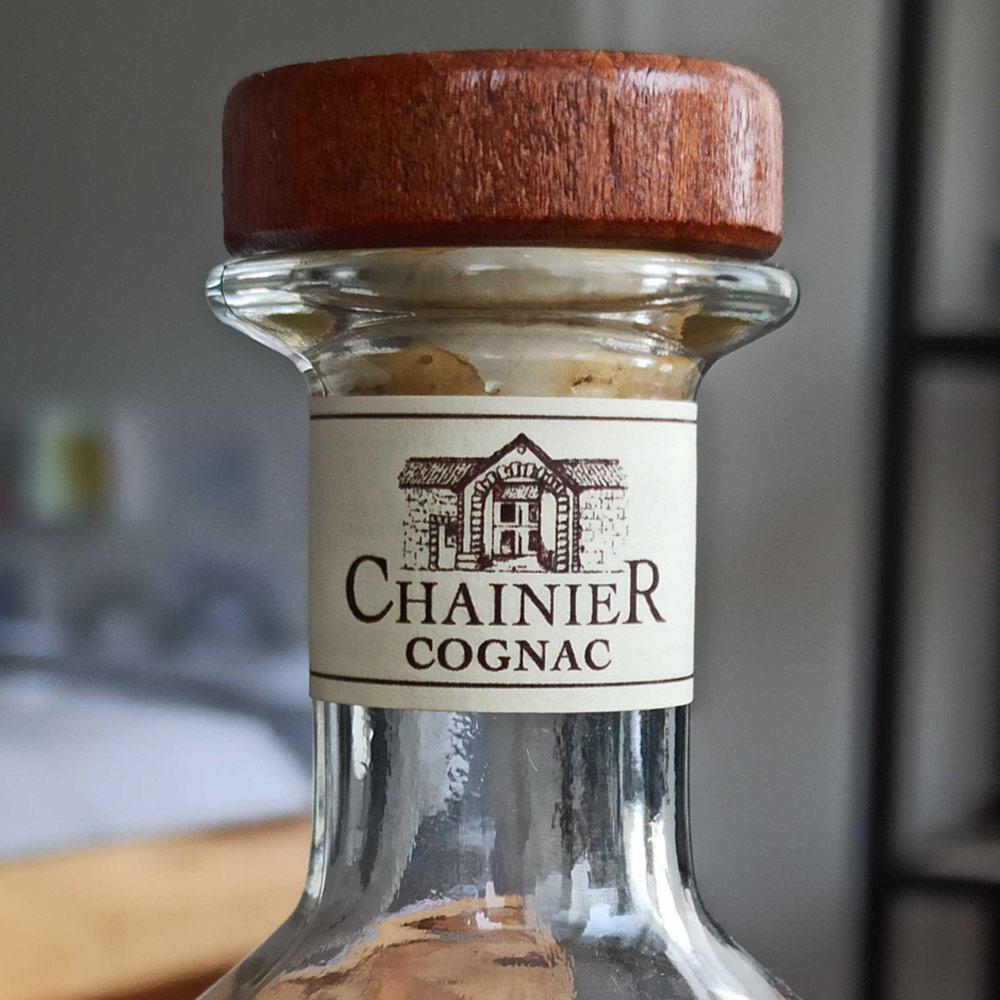
Let’s dive into more specifics on the domaine and their production before getting to tasting notes on the Chainier XO Grande Champagne, the Chainier Très Vieille Réserve, and the Chainier Grande Champagne Millésimé 1989.
Production Details
Domaine Chainier has been producing Cognac for generations, but the age of selling their own Cognac production began in 1975. I make the assumption that before then, and still now, that the domaine sells a percentage of its wines and eaux-de-vie to the large Cognac houses. The domaine is firmly established in Arthenac, in the heart of the Petite Champagne, but in 1988 they purchased 18 hectares up the road in Lignières-Sonneville, in the Grande Champagne. Therefore, Chainier’s Cognac production consists of Petite Champagne, Grande Champagne, and Fine Champagne Cognacs, all coming from the 40 hectares of vines in Arthenac and Lignières-Sonneville.
I can also add that they generally favor 400 liter oak barrels coming from the Limousin forest. Recall that oak from the Limousin forest has a wide grain, from which an eau-de-vie can extract more tannins, and thus a greater footprint from the oak. Contrariwise, oak from the Tronçais forest (a small section of the Allier forest) has a much finer, tighter grain, which gives finer tannins to an eau-de-vie, and leads to fruit-forward eaux-de-vie with a less pronounced oak signature. These are only generalizations. Moreover, the cellars at the Chainier property in Arthenac are dark and humid, which give rounder more supple Cognacs.
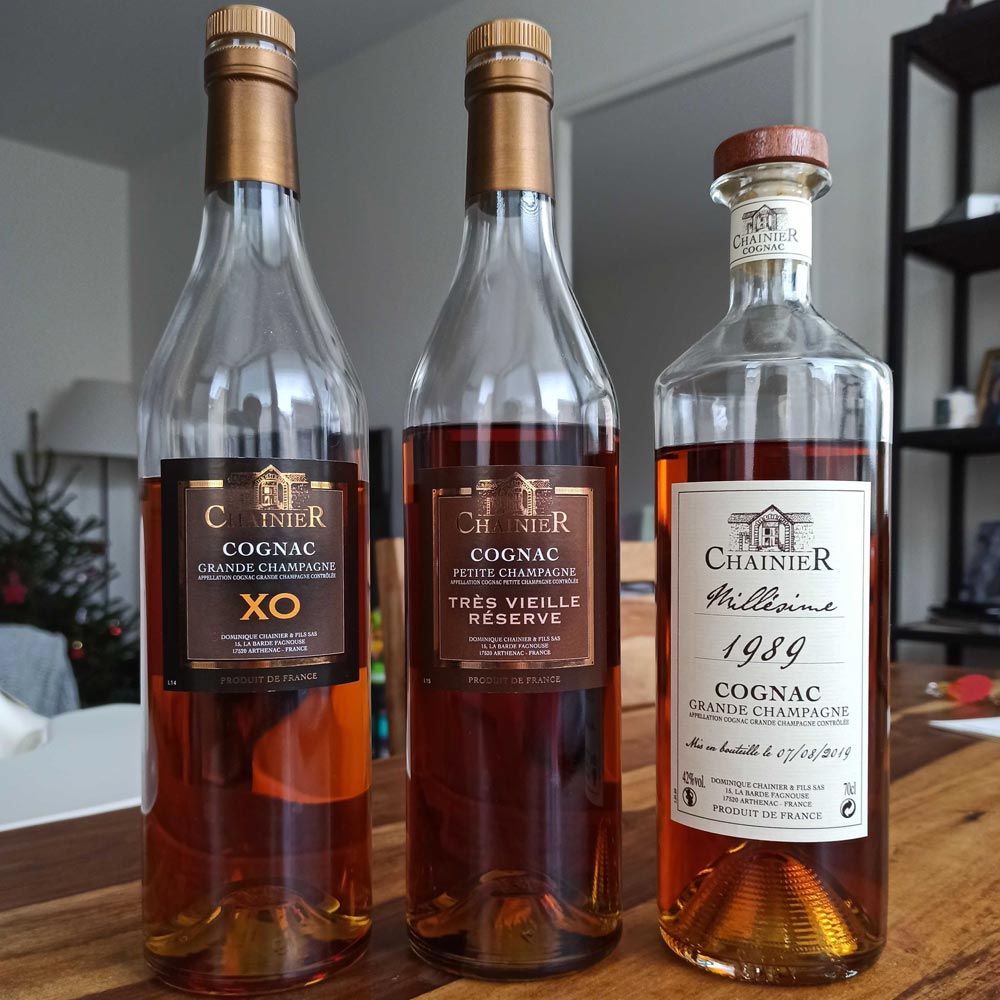
With regard to the specific Cognacs in this review, the Chainier XO Grande Champagne is a blend of Ugni Blanc eaux-de-vie which is aged in new Limousin oak barrels for six to eight months. After this contact with new oak, the eaux-de-vie are transferred to roux barrels, essentially used barrels that no longer impart any tannins to the eau-de-vie, just a slow gentle oxidation. The eaux-de-vie then rest in the dark humid cellars until they reach their twenty year old birthday, and shortly thereafter are bottled. The XO is bottled at 40% ABV.
The Chainier Très Vieille Réserve comes entirely from the domain’s vines in the Petite Champagne. No information is mentioned about grape variety, but it should be easy to assume that Ugni Blanc is the main grape – maybe also a tiny percentage of Colombard. Regarding the use of new oak, no information is provided, but it is stated that the eaux-de-vie aged in barrels – most likely used barrels – for thirty years. It too is bottled at 40% ABV.
Finally, the Chainier Grande Champagne Millésimé 1989, was bottled on August 7, 2019 making this essentially a thirty year old Cognac. Additionally, given that the Chainier family only purchased their 18 hectares of Grande Champagne vines in 1988, the eaux-de-vie that make up this 1989 vintage Cognac must come from the family’s second, maybe first, harvest in possession of those vines. It is bottled at 42% ABV.
For the three Cognacs above, I have no indication if any coloring or dosage (sugar addition) was used. But from looks alone, the colors all look to be natural. I will not even pretend to suggest that I can sense a light dosage in a Cognac. When a dosage is done with a heavy hand, I can indeed feel it; anyone can. That being said, in the Cognacs that I have tasted that for sure do not have any dosage, the common denominator is freshness, a feeling of lightness, and a drier sensation in the mouth. These three Cognacs all have that, so perhaps there is no dosage, perhaps not.
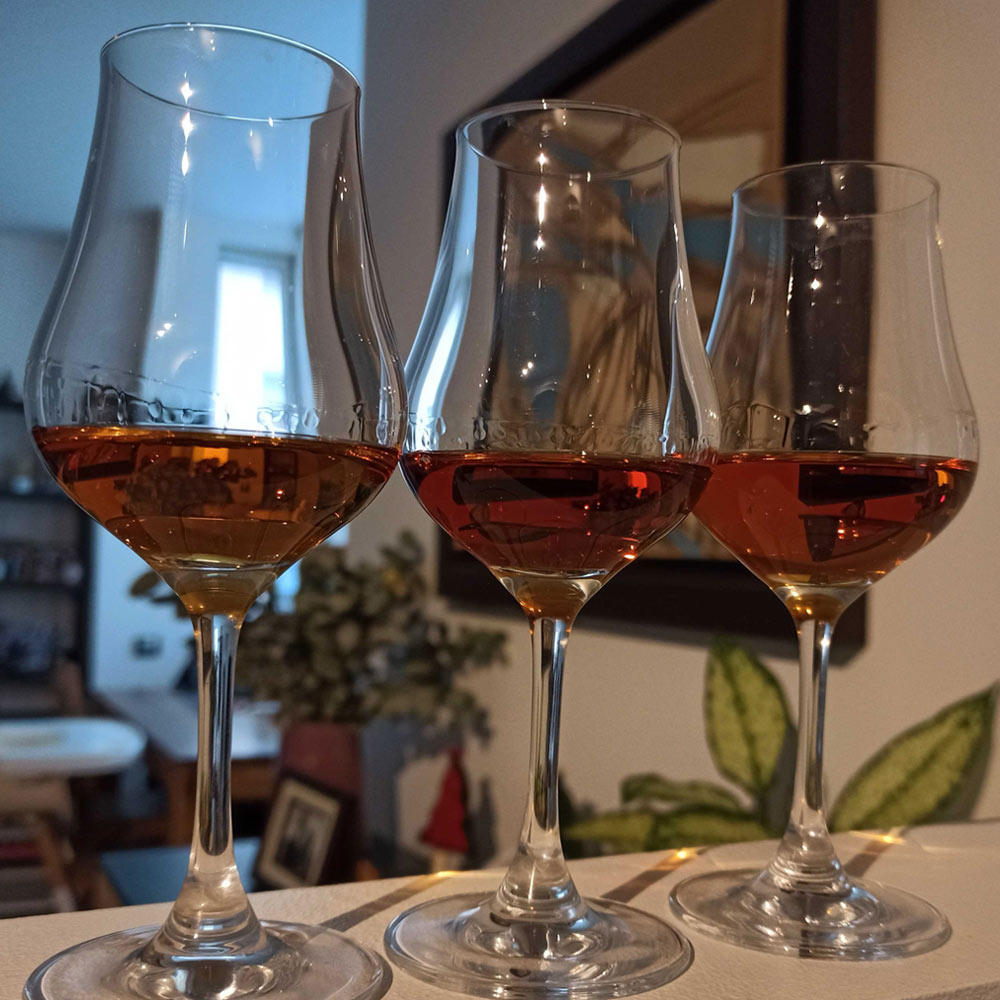
Lastly, I feel compelled to highlight that the minimum ages for the XO and Très Vieille Réserve are quite remarkable for such a small production, but one must consult the producer’s website, or talk with them directly, to get this information. As I hinted at before, their bottle presentation and packaging is very simple and so does not give any of these details on the labels. About that…
Bottle Presentation & Packaging
This section will be shorter than usual for the simple fact that there is not much to comment on regarding the overall bottle presentation and label. I adore the two bottle formats chosen by the producer: the ultra classic cognacaise bottle for the XO and the Très Vieille Réserve, and the crafty watch style bottle for the 1989 Millésimé.
The labels are clean and compact, but perhaps on the border of being a little tired. Please remember these are subjective statements of my own personal preference. To be perfectly honest though, I take no issue whatsoever with the front labels. Sure, they could use a refresh, but a simple label will never be a reason for me to ignore a bottle.
My biggest gripe is with the back labels on the XO and Très Vieille Réserve. There is a back label, which is great and I’d love to see more of in the region, but it is not populated with information I’d consider to be meaningful. The block of text states that the Cognac comes from the producer’s own property, that the wine was then double distilled, and then aged in oak barrels. That information can be considered as obvious. Anyone who does a casual search about Cognac production can gather that relatively easily.
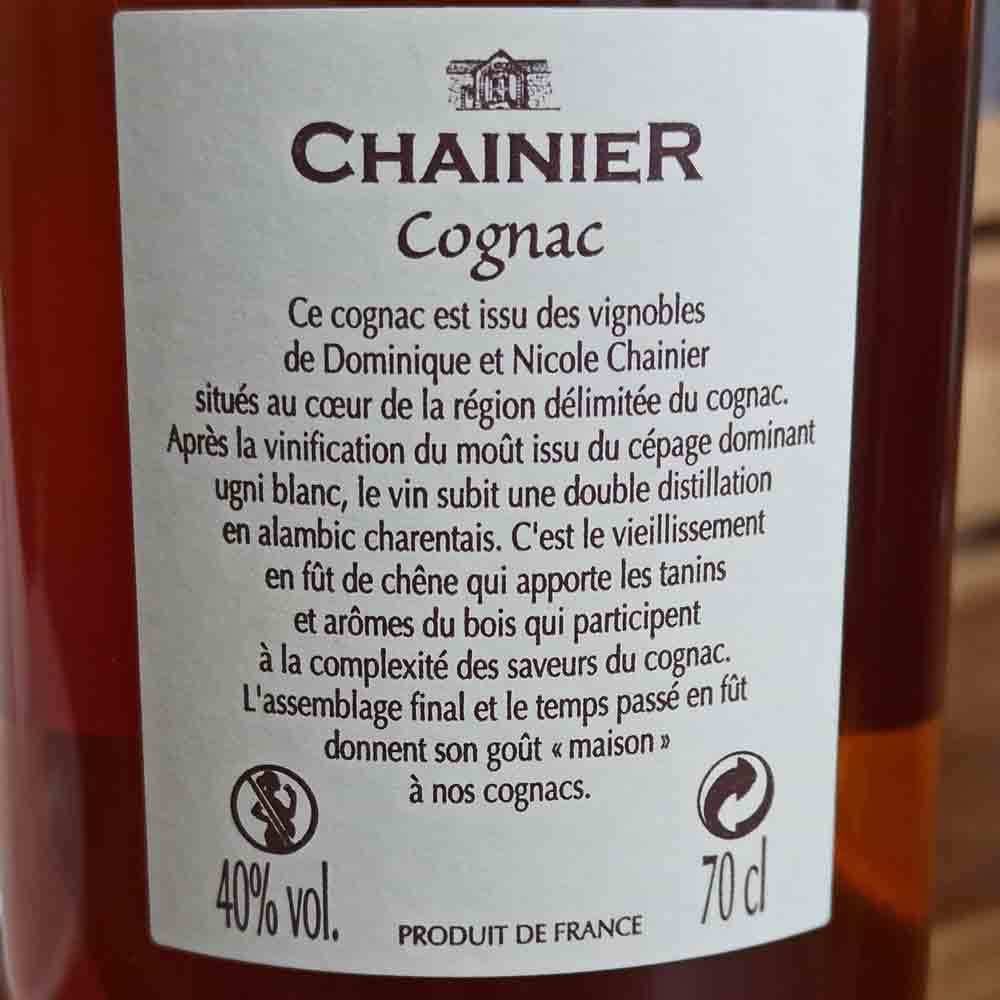
What would I love to see on these back labels? How about some production details? In previous articles, I’ve come to terms with having a simple statement of age and some mention of additives or no additives (natural color, zero dosage) for blended Cognacs. That would be a welcomed minimum of information. But, given that Chainier has included a back label – something I love to see – why not cram as much meaningful information as possible onto it?
Grape variety, barrel volume, barrel provenance and grain, humid or dry cellar, statement of age, natural color, zero dosage, etc. At best, the taster will care about this information and gain something positive from seeing it on the label. At worst, the taster will not care and the result will be no different than if it is not included. To be clear, for Cognac blends I’m perfectly fine with just a statement of age and color and dosage information. But any of the other details listed above would be welcomed. A back label is a perfect place for this information.
A special note is deserved for the Chainier Grande Champagne Millésimé 1989. Chainier has done one very important thing on the front label, something that too few producers do with vintage Cognac: print the bottling date. This is crucial information so the taster has an exact idea of how old the Cognac aged in barrel before bottling. For example, a 1989 Cognac bottled in 1999 will be entirely different from a 1989 Cognac bottled in 2019.
If no bottling date or year is stated, how can anyone know the true age of the product? Vintage Cognacs are not like wine; no evolution occurs once the Cognac is bottled. So I send a huge bravo to Chainier for including that information. The label on the Millésimé Cognac does indeed have a minimal but crafty look, as if it were a small sample on the master blender’s rack.
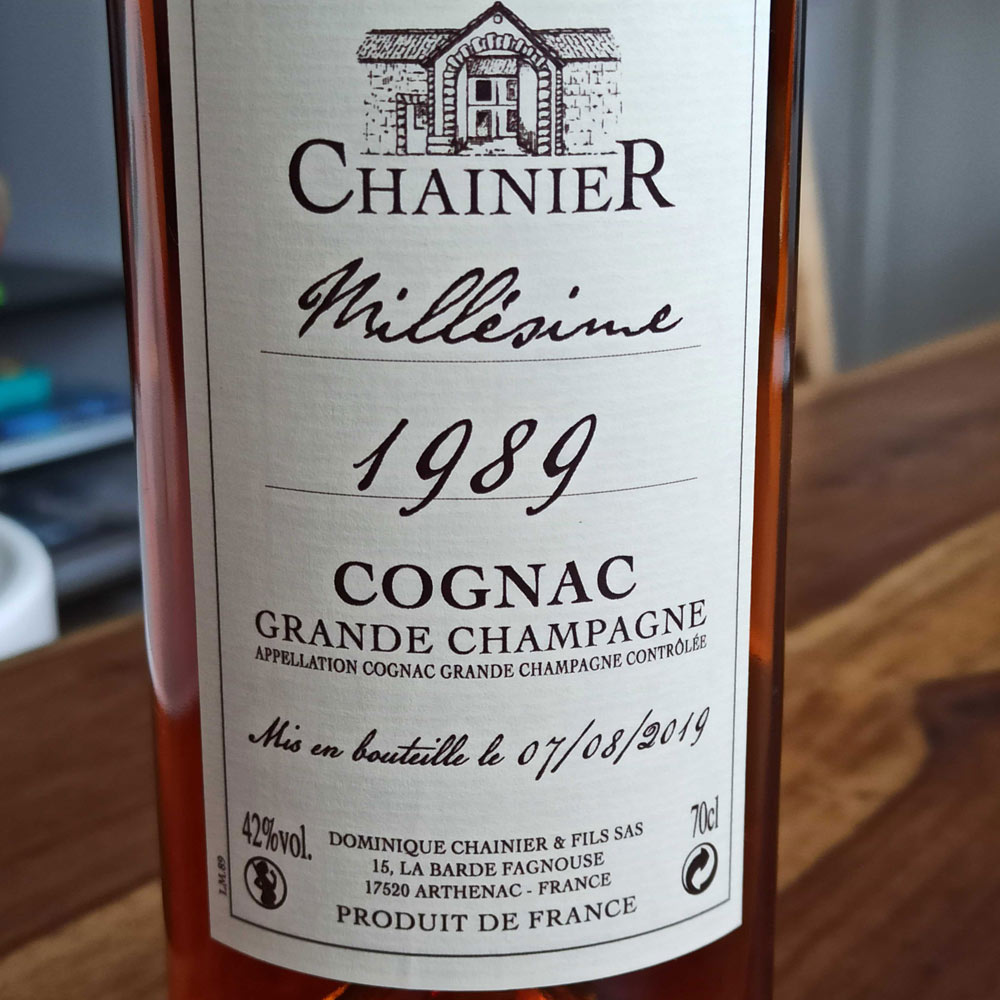
Anyways, these are just details and should not distract from the Cognac in the bottle.
Tasting Conditions
The following bullet points give several details on how the tasting notes to follow were constructed:
- The Cognac was tasted over a period of seven non-consecutive days
- Glass: Lehmann Eau de Vie 15
- A “control” Cognac was included during three of the tasting sessions. For this review, the control Cognac was a Cognac bottled at 40% ABV. It’s a bottle I know well and taste frequently – for this review, the Tiffon XO.
- Tasting duration: approximately one hour per tasting
- A personally-adjusted printed Cognac Aroma Wheel was by my side for each tasting, which helps me associate words to the smells and flavors I pick up while conducting the tasting.
I can’t recommend using a control Cognac and the Cognac Aroma Wheel enough. Sure, there are plenty of moments where I just want to shut everything down and sit back and enjoy a glass of Cognac. But there are other times when I want to approach the tasting more academically, with an aim to reflect more on what exactly my nose is smelling and what my palate is tasting and feeling in terms of flavors and textures. The control Cognac and the aroma wheel help bring greater clarity to these focused tasting occasions. Still, let’s not forget that tasting is a personal experience – and a very subjective one at that.
So what do these Cognacs taste like?
Tasting Notes
Chainier Cognac XO
Nose: Nice nose here! It smells like there is a lovely alliance between fruit and spice. It does not have the age where a strong oak signature might stick out, and even though twenty years old is anything but young for a Cognac, it does not yet have the maturity to hit the wafty aroma profile like the 1989 Vintage below. From the first sniffs, it seems to do a good job straddling youthful bright fruit and spicy oak maturity. There is a pastry note as well.
At the risk of sounding random, I also pick up a generic woodsy men’s perfume – Jovan Musk was the cheap men’s perfume I recall lying around the bathroom back in the day. Out of curiosity I looked up that perfume’s base notes and they are as follows: lime, pepper, carnation, lemon, amber, lavender, spearmint, exotic spices, woods and musk. Not too surprisingly, with the exception of carnation (no idea what that smells like), those aroma notes are somewhat spot on for this Cognac. I find it funny how the mind can unknowingly wander when tasting and take me to a smell so random as Jovan Musk, a smell I haven’t smelled in twenty years, easily.
Anyways, this is a very positive nose. This Chainier XO smells like a benchmark Cognac.
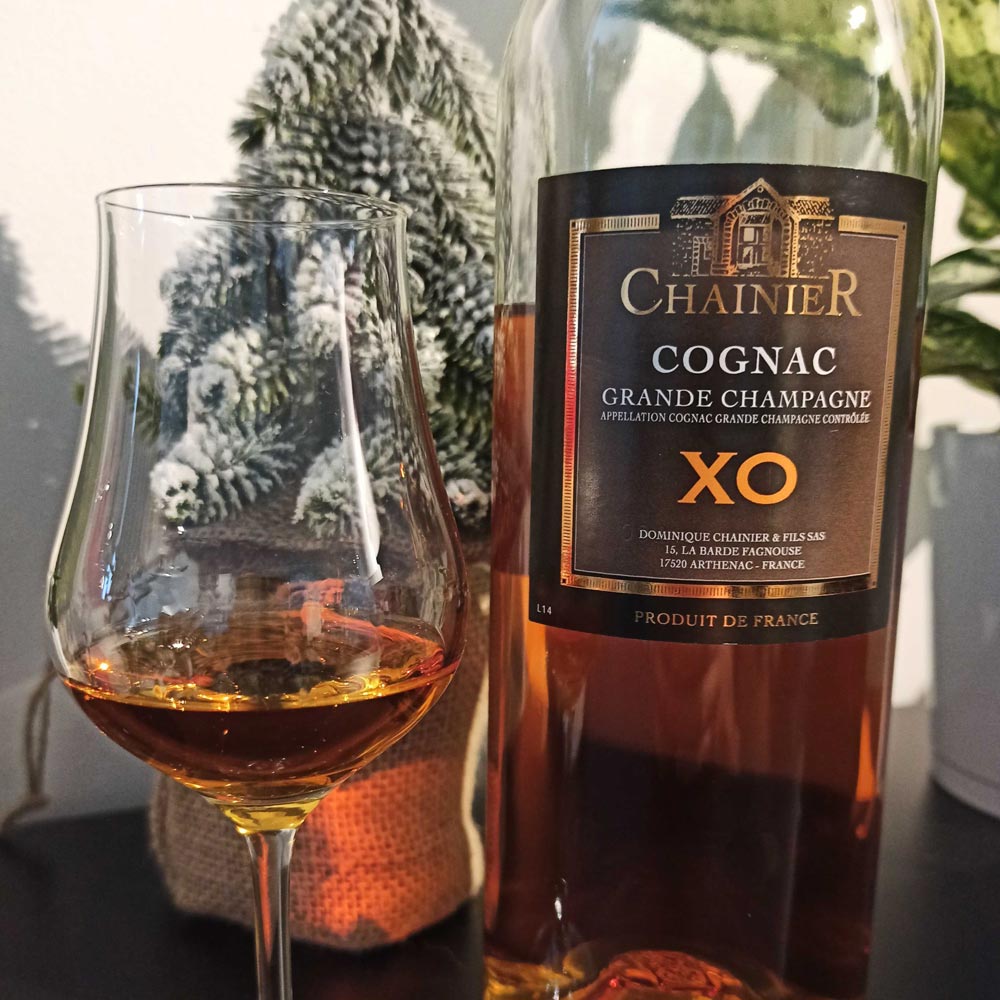
Palate: Yes. The first thing I notice is the freshness of the Cognac. There is zero ounce of heaviness. This is elegant and light on its feet. It has a round mouthfeel without being too high on the richness scale – so the richness does not compete with the feeling of freshness. As far as fruits go, imagine a fruit cup (Dole was my brand of choice as a youngster) with sweet pineapple, peaches, pears, and the stray grape or two.
And let’s not forget the fruit juice/syrup in that cup as well. There is also a slight taste of vanilla and a more general feeling of tasting something dessert-y. But again, there is no feeling of sweetness or heaviness here. The Cognac is balanced and lively; each sip invites the next. I’m really enjoying this. It ticks all of the boxes for an XO quality Cognac, and more.
Finish: The finish is moderate at best, and the flavors and other sensations only linger for a short while before leaving entirely. But I keep coming back to this feeling of freshness. This Cognac, from the entry all the way through to the finish, feels so bright, so lively. The drinkability is off the charts here.
Chainier Cognac Très Vieille Réserve
Nose: Interesting. The first note that greets my nose is a dusty old wood note. This is also joined by a general nuttiness and mixed spices. Cocoa powder is there as well. The nut, spice, and cocoa notes are pleasant, but this dusty note sticks out. It’s one of those things that might have been hard to sense if the Cognac was sipped by itself, but because I had three other Cognacs alongside (XO, 1989, and control Cognac) I noticed it consistently.
Dustiness perhaps makes little sense as a smell, but I imagine a dusty wooden bookshelf in an old room that lacks air circulation. It really is not unpleasant, just very different. We’re far away from any overt fruitiness. Whatever fruit is present seems more of the candied and dried fruit varieties. Here wood, spices, and rancio and running the show. It’s quite complex really, but I question if this Cognac will still have any freshness and fruit left to show.
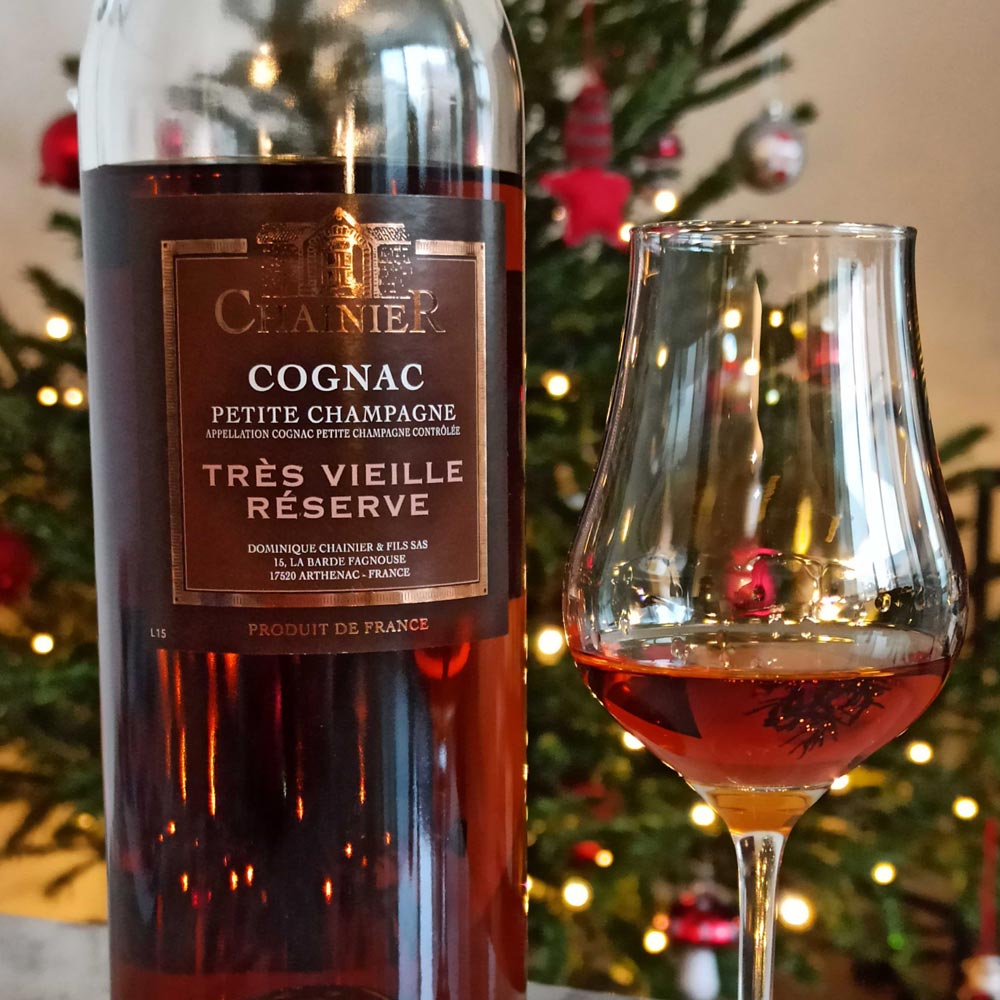
Palate: The dusty wood note does not show up in the mouth as a flavor. The Cognac has a nice soft and fine texture. It is richer in texture than it is in flavor. A fine spiciness from the 30 years aging in oak is felt right away. Then comes bitter cocoa powder, nuts, dried fruits like raisins and prunes, a slight roasty espresso flavor, and vanilla.
The Cognac Aroma Wheel divides the aroma and flavor notes typically found in Cognac into Spring Flowers, Summer Fruits, Autumn Spices and Winter Woods. This Cognac sits somewhere between the Fall Spices and Winter Woods. For my palate, it’s lacking a touch of fruit and freshness, but I can easily see how a taster who prefers a more wood-forward and spice-forward Cognac would be all over this.
Finish: This finish is medium with moderate persistence. A gentle bitterness sets in once the Cognac is swallowed. It’s not tannic or astringent on my tongue and the sides of my cheeks but just bitter, lacking a little bit of gourmandise. For what it’s worth, I’ve also felt this gently bitter sensation sometimes when drinking tea. An interesting Cognac, but ultimately I’m indifferent.
Chainier Cognac Grande Champagne Millésimé 1989
Nose: With time in the glass, the Cognac’s aromas waft from the glass. First, there’s ultra-fine fresh grated vanilla and tingly fall spices like cinnamon, nutmeg, clove, and allspice. Lately I’ve been drinking a lot of Christmas Tea, which has loads of these soft warming spices. Then comes the fruit, but here the fruits are heading more towards stewed fruits, verging on jammy fruits.
I imagine a pot in which apricots, peaches, quince and orange peel are all stewing away coated with a generous dusting of the above spices. This is an utterly lovely nose. It’s pure, elegant, and seductive and demands to be smelled over and over again. And this one must not be rushed. With each passing minute the nose evolves, so it would be a shame to miss out on all that it has to offer.
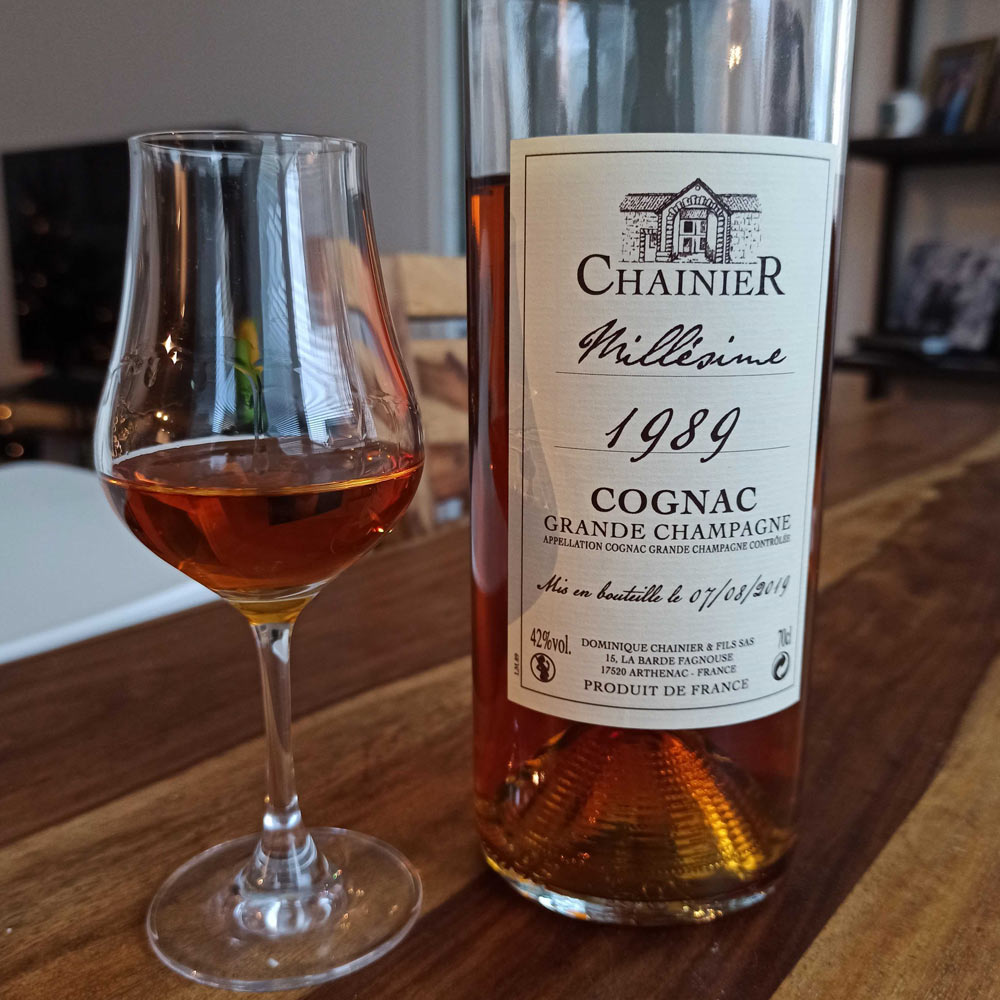
Palate: In the mouth, the Cognac is extremely balanced and has a rich texture that coats all corners of the mouth. The tug of war between the stewed fruits and the spice mix is perfect. And all of the above fruit and spice notes are present. Also, a very high quality fruit paste – apricot or quince – immediately comes to mind (Fruit pastes are a recent discovery of mine. Go to any fine epicerie here in France, and you’ll likely see a large offering of these artisanal fruit pastes. They’re not to be missed.).
There is also an interesting mouthfeel sensation in that the overall feeling is of lightness and finesse, but swirling the Cognac around in the mouth a little confirms that there is in fact an elevated roundness and richness. These are seemingly contradictory descriptors, but I see it as a major positive when a Cognac that is inherently rich can deliver itself on the palate with this graceful feeling of lightness.
Finish: Solid finish. There is no disappearing act thankfully, nor do the Cognac’s flavors and sensations last an eternity either. Once the Cognac is swallowed, the flavors and sensations slowly fade out. No bitterness. No abrasive wood tannins. No tea astringency. No strong footprint from the oak. The fruit and spice flavors have a nice persistence. I found it extremely pleasant to finish a sip of this Cognac keeping my mouth closed and then simultaneously reach for the glass to continue to smell the wafty aromas.
Chainier has definitely selected something special with this 1989 vintage Cognac. It may also be thirty years old like the Très Vieille Réserve, but the fruit, spice, and wood profile are completely different. Excellent!
Conclusion
In the introduction, I mentioned that I tend to have a high propensity to like Cognacs from producers such as Domaine Chainier. And here, I do indeed like what I see, smell, and taste. All of the Cognacs feel true. Their unassuming look of quiet confidence is a welcomed departure from so much of the glitzy flashy bottlings found in the region. The only thing that should attract a taster’s attention is the Cognac inside. I find a great sense of truth in that.
I appreciate that the Cognacs do not overlap with one another, and each deserves its place in the range. The aroma and flavor profiles are wildly different and everyone can find their pleasure with at least one of these products.

The Chainier XO is a model XO Cognac blend. More generally, I’d classify it as a benchmark Cognac. On a few of the tasting occasions, I thought that the Chainier XO would be the Cognac I’d pull out if a friend or guest was curious about Cognac but had no experience with the spirit whatsoever. Also, it represents tremendous value for money.
I’ll even put the Chainier XO right up there with the Audry XO, an extremely popular XO Cognac over the years. Here though the Chainier is brighter and fresher with its fruit – less creamy and rich compared to the Audry. Different for sure, but equally up there in terms of quality. If I consider price and quality in the glass, the XO is hands down my winner of this trio.
The Chainier Très Vieille Réserve has a more oak forward and rancio profile. It’s actually not an aroma profile I got along with too well on these tasting occasions. Seven days of tasting was plenty for me to make this conclusion. So while this is not my preference in smells and flavors, I can see this doing very well with fans of more oak forward, toasty, rancio styled Cognacs.
A thirty year old Cognac at this price is really quite something too. And once again, the lack of overlap in the Chainier range means you’ll very likely find the Cognac that suits you best, even if that means you do not get on well with all of them, as was the case for me.
Finally, the Chainier Grande Champagne Millésimé 1989 is clearly a cut above the other two Cognacs, but it should be as the producer singled out this Cognac to be officially sealed for later bottling as a vintage Cognac. That inherently means the Chainier family knew there was something special about this lot. And it is truly special.
It has the best marriage between fruit, wood, and spice – this in a word is complexity. The aroma profile is intriguing and each sniff invites you to discover what’s still to unfold in the coming minutes. The price tag is sharper here, but given the quality and the age, it is warranted. I’ll look forward to tasting through this 1989 and waiting impatiently for the Domaine’s 1990 and 2000 vintage Cognacs to be released. This is real Cognac!
Bravo Domaine Chainier!







